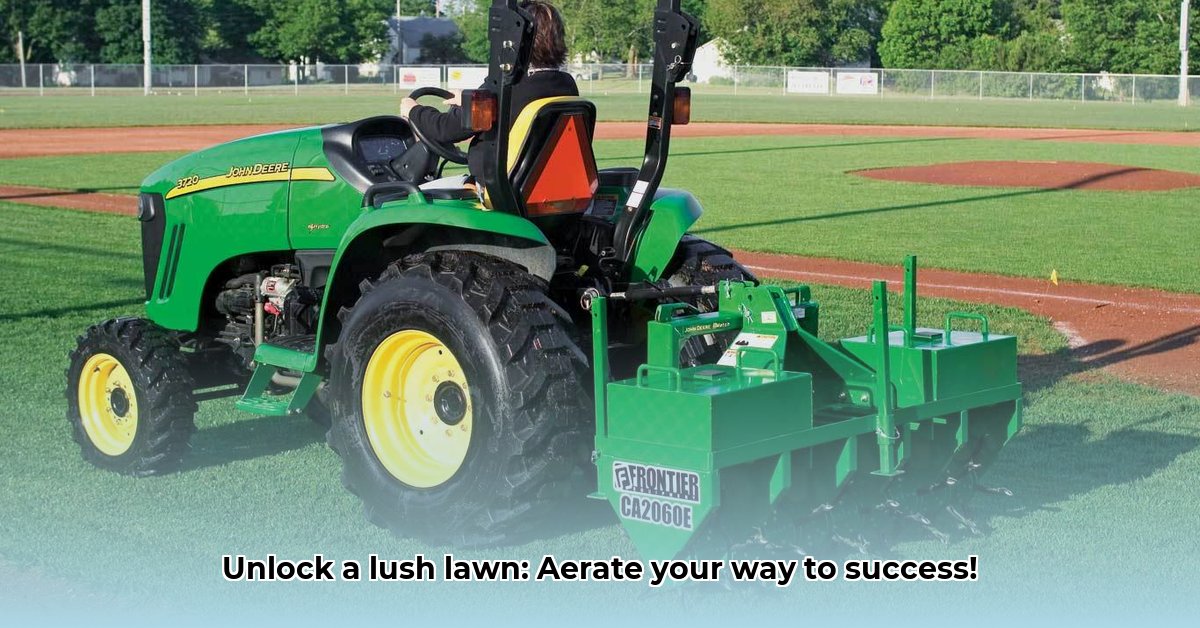
Understanding the Importance of Soil Aeration for Sustainable Lawn Care
A lush, green lawn isn't just aesthetically pleasing; it's a testament to healthy soil. Compacted soil restricts water and nutrient uptake, leading to weak, vulnerable grass susceptible to disease and pests. This limits the overall health of your lawn and potentially forces reliance on chemical solutions. Aeration, however, revitalizes your lawn's ecosystem. It creates pathways for water, air, and nutrients to reach the roots, promoting robust growth and reducing the need for excessive watering and fertilizers. Did you know that properly aerated soil can reduce water usage by up to 15%? For more information on lawn tractor attachments, check out this helpful resource.
How Lawn Tractor Aerators Work
Lawn tractor aerators are specialized attachments designed to break up compacted soil. Two main types exist:
- Hollow-tine aerators: These remove cylindrical plugs of soil, creating significant channels for improved air and water penetration (ideal for heavily compacted clay soils).
- Solid-tine aerators: These pierce the soil, creating smaller holes (suitable for lighter aeration or sandy soils).
The choice depends on your soil type and compaction level. Heavily compacted clay soils benefit most from hollow-tine aerators; sandy soils may only need the lighter touch of solid tines.
Choosing the Right Aerator
Selecting the proper aerator requires careful consideration:
- Lawn Size: Larger lawns necessitate more powerful and wider aerators to minimize time and effort.
- Soil Type: Clay soils require more aggressive aeration than sandy soils.
- Aerator Type: Choose hollow-tine for heavy compaction, solid-tine for lighter needs.
- Tractor Compatibility: Verify compatibility with your lawn tractor's specifications before purchasing.
Step-by-Step Guide to Using a Lawn Tractor Aerator
- Pre-Aeration Prep: Mow your lawn to a consistent height (1-2 inches) 1-2 days prior. This enhances soil accessibility.
- Securely Attach Aerator: Carefully attach the aerator to your tractor, following the manufacturer's instructions precisely. Safety is paramount!
- Depth Adjustment: Adjust the depth setting according to your soil type. Start shallow and adjust as needed.
- Overlapping Passes: Overlap each pass by approximately 50% to ensure complete coverage. This is crucial for an even aeration pattern.
- Continuous Monitoring: Regularly inspect the aerator's operation. Immediately address any clogs or irregularities.
- Post-Aeration Watering: Lightly water the lawn after aeration to help settle the soil and encourage root growth.
Maintenance and Storage
Proper maintenance extends your aerator's lifespan:
- Cleaning: Thoroughly clean the aerator after each use.
- Lubrication: Lubricate moving parts regularly (check your manufacturer's manual for specific instructions and frequency recommendations).
- Storage: Store in a dry, sheltered place to minimize rust and damage.
Troubleshooting Common Problems
- Clogged Tines: Clean promptly to prevent reduced effectiveness.
- Bent Tines: Repair or replace bent tines to ensure even aeration.
- Uneven Aeration: Adjust depth settings, increase overlap, or consider a different aerator type.
Conclusion: Sustainable Lawn Care Through Efficient Aeration
Aerating your lawn isn't just about aesthetics; it's a fundamental aspect of sustainable lawn care. By improving soil health, you foster a resilient lawn requiring less water and fewer chemical inputs. This environmentally conscious approach reduces your carbon footprint and conserves valuable resources. "Healthy soil is the key to a healthy lawn and a healthier planet," states Dr. Emily Carter, Professor of Soil Science at State University. Invest in a lawn tractor aerator: it's an investment in a greener future.